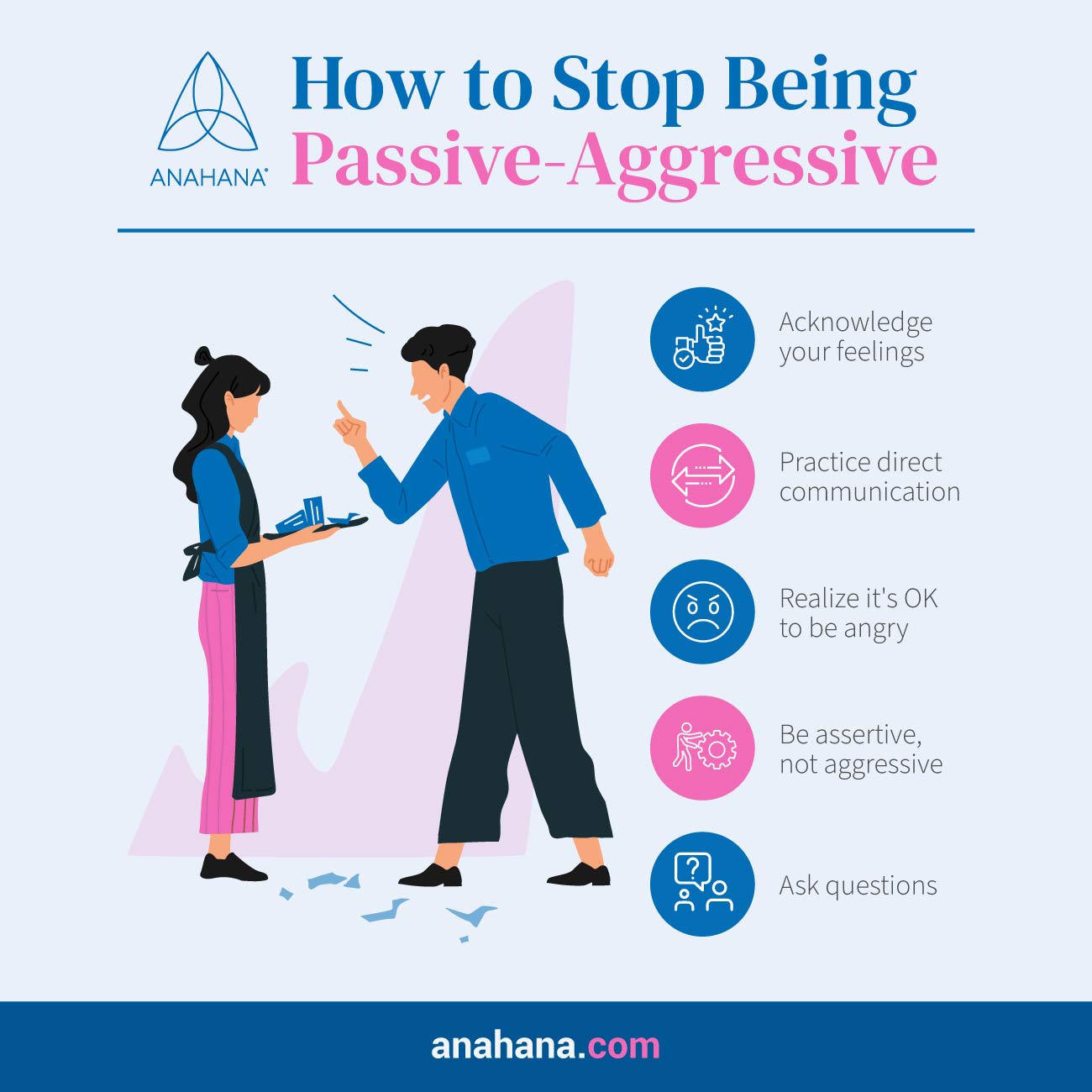
Table of Contents
Dive into the world of passive-aggressive behavior with our detailed guide. Uncover the key indicators and psychological underpinnings of this communication style, and gain practical tips for responding effectively in person
What Is Passive-Aggressive Behavior Explained
Passive-aggressive behavior is a complex, indirect method of expressing negative emotions. It's not just about avoiding confrontation; it's a strategy used when a person feels threatened or powerless to express their feelings directly.
This behavior is characterized by passive resistance to expected tasks and indirect expression of hostility. At its core, passive-aggressive behavior stems from a person's struggle with expressing anger, disappointment, or frustration openly.
Instead of addressing issues head-on, you may resort to subtle methods like procrastination, stubbornness, or intentional inefficiency.
These actions are often a defense mechanism used when expressing emotions directly is perceived as risky, uncomfortable, or socially unacceptable.
This behavior can emerge in various settings, including personal relationships, the workplace, or family dynamics.
It often reflects deeper issues related to communication skills, self-esteem, or past experiences where direct expression was met with negative consequences.
Understanding the nuances of passive-aggressive behavior is essential for recognizing and addressing it effectively, both in yourself and others.
5 Examples of Passive-Aggressive Behavior
Passive-aggressive behavior takes many forms, each sending mixed messages. It's important to understand these examples if you're displaying this behavior yourself or spotting it in others:
- Silent Treatment: This involves ignoring someone as a means of punishment or expressing displeasure, denying the person a chance to resolve the issue through direct talk.
- Backhanded Compliments: Seemingly kind remarks that carry a critical undertone often confuse the recipient about the giver's true intentions.
- Intentional Mistakes: Subtle acts of rebellion, like making purposeful errors in work or personal responsibilities, often to express anger or dissatisfaction.
- Procrastination: Deliberately delaying tasks, not just due to laziness, but to exert control or indirectly show resentment.
- Sarcasm and Snide Comments: Using humor or sarcasm to veil criticism or disdain, masking the person's real feelings under the guise of jokes.
What Causes Passive-Aggressive Behavior
Passive-aggressive behavior often has deep psychological roots. It can be a learned response from family dynamics where open expression of emotions was discouraged.
You might adopt this behavior as a coping mechanism when you feel powerless or unable to express your anger and frustration directly. It's a defense mechanism that serves as a shield against confrontation.
Why Passive Aggressive Behavior is Dangerous
Passive aggression is insidious and damaging. It erodes trust and communication in relationships, be it personal or professional.
The indirect nature of this behavior creates an environment of confusion and mistrust. It can lead to a breakdown in communication, as the true message gets lost in the passive-aggressive delivery.
This behavior pattern can perpetuate a cycle of unresolved relationship issues and lingering resentment.
How to Spot Passive-Aggressive Behavior

Recognizing passive-aggressive behavior is crucial in understanding and addressing underlying issues in communication. Here are three key points to help identify passive-aggressive behavior:
Inconsistent Verbal and Non-Verbal Communication
A passive-aggressive person may say one thing, but their body language or tone of voice says another.
For example, they might agree to a request but then sigh heavily, roll their eyes, or show non-verbally reluctance or resentment.
Avoidance of Direct Conflict
If you’re showing passive-aggressive behavior, you might often avoid confrontation. Instead, you express your displeasure indirectly.
This can be through procrastination, intentional inefficiency, or 'forgetting' to do important tasks.
They might agree to something they disagree with, only to express their disagreement through these indirect actions.
Sullen or Resentful Attitude
A consistent sullen, sulky, or resentful demeanor can signify passive-aggressiveness.
This might include giving people the silent treatment, making snide remarks, or using sarcasm frequently. These behaviors are often attempts to express negative feelings without engaging in open dialogue.
It's important to approach such situations with understanding and a willingness to communicate openly, encouraging the person to express their real feelings more constructively.
Dealing with Passive-Aggressive People
Interacting with someone who exhibits passive-aggressive behavior can be challenging. It requires patience and a strategic approach. Here's how to deal with passive-aggressive people effectively:
- Stay Calm and Objective: When you encounter passive-aggressive behavior, remain calm. Don't react emotionally, as this can escalate the situation. Stay focused on the issue at hand, not the person's attitude.
- Encourage Open Communication: Create a safe space for the person to express their feelings. Ask open-ended questions to encourage them to communicate directly. Say things like, "I've noticed you seem upset. Can we talk about what's bothering you?"
- Set Boundaries: It's important to set clear boundaries. Let the passive-aggressive person know that indirect expressions of anger or resentment are not helpful. Emphasize the need for direct and honest communication.
Is Passive Aggressiveness a Mental Disorder?
Passive-aggressive personality disorder, in itself, is not classified as one of the mental health conditions. However, it can be indicative of underlying psychological issues, such as personality disorders.
It's a behavioral issue that often requires psychological intervention to address the underlying causes and to learn healthier ways of expressing emotions.
How to Stop Being Passive-Aggressive
Overcoming passive-aggressive behaviors involves self-awareness and a commitment to change. Here are key steps to help stop this behavior:
- Acknowledge Your Feelings: Start by recognizing and accepting your true emotions. Admitting that you feel angry or resentful is the first step towards change.
- Practice Direct Communication: Work on expressing your feelings and needs openly and respectfully, without sarcasm or hidden meanings.
- Seek Help if Needed: If passive-aggressive behavior is deeply ingrained, consider seeking professional help. Therapy can offer insights and strategies for better communication.
- Reflect on the Impact: Understand how your behavior affects others. Reflecting on the consequences of your actions can motivate you to adopt healthier communication patterns.
The Danger of Letting Passive Aggression Go Unchecked
Ignoring passive-aggressive behavior can have long-term detrimental effects on relationships and workplace dynamics. When such behavior is not addressed, it creates a toxic environment where open and honest communication is stifled.
This can lead to resentment and mistrust, negatively impacting team cohesion, personal relationships, and overall mental health and well-being.
When you recognize passive-aggressive behavior, you can foster healthier, more authentic interactions and relationships.
Whether you realize you're dealing with such behavior in yourself or others, it's about creating an environment where feelings can be expressed openly and respectfully.
Frequently Asked Questions
What are common signs of passive-aggressive behavior?
Common signs of passive-aggressive behavior include subtle acts of resistance like procrastination, intentional inefficiency, and silent treatment.
Other indicators are sarcasm, backhanded compliments, and non-verbal cues contradicting verbal statements. Recognizing these signs can be crucial in understanding and addressing the behavior.
Why do people exhibit passive-aggressive behavior?
Passive-aggressive behavior often stems from an individual's inability to express negative emotions directly.
It can be rooted in past experiences where open communication was discouraged or met with negative consequences.
Other factors include fear of conflict, feelings of powerlessness, and a lack of assertiveness skills.
How can you deal with passive-aggressive behavior effectively?
Dealing with passive-aggressive behavior involves clear, direct communication and setting firm boundaries. Addressing the behavior calmly and assertively is important, as well as encouraging open dialogue.
Understanding and empathy can also be helpful, as the behavior often stems from deeper emotional issues.
In some cases, professional help like therapy may benefit the passive-aggressive individual and those affected by their behavior.
References
Passive-aggressive behavior - Wikipedia
7 Signs You're Dealing With a Passive-Aggressive Person | Time
How To Tell if You (or Someone Else) Are Being Passive-Aggressive
10 Strategies For Dealing With Passive-Aggressive People - Crisis & Trauma Resource Institute
How to Deal with a Passive-Aggressive Colleague
Disclaimer
The contents of this article are provided for informational purposes only and are not intended to substitute for professional medical advice, diagnosis, or treatment. It is always recommended to consult with a qualified healthcare provider before making any health-related changes or if you have any questions or concerns about your health. Anahana is not liable for any errors, omissions, or consequences that may occur from using the information provided.

By: Anahana
The Anahana team of researchers, writers, topic experts, and computer scientists come together worldwide to create educational and practical wellbeing articles, courses, and technology. Experienced professionals in mental and physical health, meditation, yoga, pilates, and many other fields collaborate to make complex topics easy to understand.
